via Boing Boing by Gareth Branwyn

I first discovered David Neat’s work via his website where he delves deeply into all sorts of fascinating interests, from furniture design to natural history to art. Mainly what drew me there was his extensive tutorials on all aspects of miniature model-making. The amount of content he’s posted is staggering, as is the quality of everything. Read comments about David’s site (or this book) and you will hear from seasoned pros, surprised by how much they’ve learned from David’s work.
Continue reading
=============================
via The Scholarly Kitchen by David Crotty
Why do we use the particular symbols we use for the numbers 1 through 10? And why base ten? The video below from Alessandra King offers a brief history of numbers, including the important shift to positional notation and the origins of our Hindu Arabic numeral system.
Continue reading
=============================
via Boing Boing by Andrea James

What happens when a whale dies? It sinks to the ocean floor, creating a whale fall, which becomes a fantastical garden of biodiversity. EVNautilus stumbled on a naturally-occurring whale fall during a live feed, an exceedingly rare find.
Continue reading
=============================
via Killer Web Directory blog by Administrator
Here is an intriguing infographic that I helped to create with the folks at London based VizionOnline that compares how popular websites looked back in the day to how they look in 2017. View then and now screenshots of websites such as the BBC, ebay, Wikipedia and Google.
Continue reading
=============================
via the Guardian by Ian Semple
A huddle of seven worlds, all close in size to Earth, and perhaps warm enough for water and the life it can sustain, has been spotted around a small, faint star in the constellation of Aquarius.
The discovery, which has thrilled astronomers, has raised hopes that the hunt for alien life beyond the solar system could start much sooner than previously thought, with the next generation of telescopes that are due to switch on in the next decade.
Continue reading
=============================
via OUP Blog by Anatoly Liberman

Perhaps the huge size of an average boulder contributed to the preservation of an extra letter in its name?
One good thing about English spelling is that, when you look for some oddity in it, you don’t have to search long. So why do we have the letter u in boulder (and of course in Boulder, the name of a town in Colorado)? If my information is reliable, Boulder was called after Boulder Creek. A boulder near a small stream won’t surprise anyone, but the letter u in the word and the place name may, as journalists like to say, raise some eyebrows. Bolder (the comparative degree of bold), older, colder, folder, and holder do without u, but shoulder, unexpectedly, sides with boulder. American spelling has mold in all its meanings and the verb molder, while the British norm requires ou before l. What is going on here?
Continue reading
=============================
via 3 Quarks Daily by Yohan J. John
As a neuroscientist, I am frequently asked about consciousness. In academic discourse, the celebrated problem of consciousness is often divided into two parts: the "Easy Problem" involves identifying the processes in the brain that correlate with particular conscious experiences. The “Hard Problem” involves murkier questions: what are conscious experiences, and why do they exist at all? This neat separation into Easy and Hard problems, which comes courtesy the Australian philosopher David Chalmers, seems to indicate a division of labor.
Continue reading
=============================
via The New Statesman by Caroline Moorhead
Kapka Kassabova’s Border: a Journey to the Edge of Europe is a timely, powerful story of immigration, friendship and travel.
When Kapka Kassabova was in her late thirties, she decided to return to the place where she had grown up, but had not seen for 25 years: the borderlands of eastern Thrace, where Bulgaria, Greece and Turkey meet. Her parents were Bulgarian scientists who, after a spell in the UK, had settled in New Zealand, where, she writes, the Kiwi speech made “fish” sound like “fush” and “chips” like “chups”, where the stars were rearranged and the seasons inverted: an “upside-down world, but then it always is, for the immigrant”. It is again as an immigrant, a wanderer, that Kassabova – who now lives in the Scottish Highlands – went to find the forbidden places of her childhood.
Continue reading
=============================
via the Guardian by Sarah Hughes

Monet’s garden at Giverny. Photograph: Seventh Art Productions
The words are those of a man at the end of his tether. “I must have undoubtedly been born under an unlucky star. I’ve just been turned out without even a shirt on my back from the inn in which I was staying. My family refused to help me any more. I don’t know where I’ll sleep. I was so upset yesterday that I was stupid enough to hurl myself into the water. Fortunately no harm was done.”
Continue reading
=============================
via Boing Boing by Peter Bebergal

I am not that interested in speculation on whether aliens have ever visited the Earth. What I am excited about, however, are all the ways we have imagined them, from the earliest grainy photos of saucer shapes in the sky to the orchestral-minded, big-eyed aliens from Close Encounters of the Third Kind. In the 1950s and 1960s, UFOs became ubiquitous in the pulp magazines and cheap popular paperbacks. With their lurid cover and claims that “Flying Saucers Have Landed,” these publications would set the popular consciousness afire. They also opened up theories of ever sort as to the origins of UFOs and what role the government might play in covering them up. From the hollow Earth, to Mars, to other dimensions, the UFO myth could contain almost any form of conjecture. Jews? Maybe. Men in black? Most certainly. Spiritual avatars leading us to a new age? Let’s hope so.
Continue reading
No comments:
Post a Comment